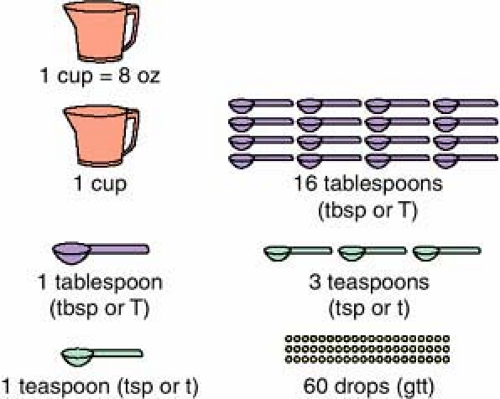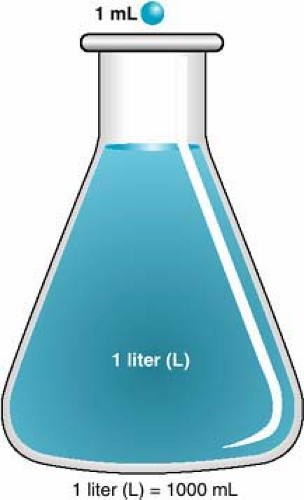Systems of Measurement and Common Equivalents
Objectives
After completing this chapter, you will successfully be able to:
Identify measurements included in the metric, apothecaries’, and household systems.
Understand abbreviations used in the metric, apothecaries’, and household systems.
Calculate intake and output necessary for accurate recording in a medical record.
Differentiate between Fahrenheit and Celsius thermometers used for monitoring temperature.
Differentiate between standard time and military time necessary for accurate recording in a medical record.
 Preventing Medication Errors
Preventing Medication ErrorsMedication calculation need not be difficult if you have a problem-solving method that is easy to understand and implement. In addition, you need to understand common equivalents and units of measurement to visualize all parts of a medication dosage calculation problem. Understanding common equivalents and units of measurement will assist you in preventing medication errors related to incorrect dosage.
This chapter will help you to understand the measurement systems used for medication administration. This knowledge is necessary to accurately implement the problem-solving method of dimensional analysis.
Systems of Measurement
Three systems of measurement are used for medication dosage administration: the metric system, the apothecaries’ system, and the household system. To be able to accurately administer medication, you must understand all three of these systems.
The Metric System
The metric system is a decimal system of weights and measures based on units of ten in which gram, meter, and liter are the basic units of measurement. However, gram and liter are the only measurements from the metric system that are used in medication administration. The meter is a unit of distance, the gram (abbreviated g or gm) is a unit of weight, and the liter (abbreviated L) is a unit of volume.
The most frequently used metric units of weight and their equivalents are summarized in Box 2.1.
Another way to understand the metric units of weight and their equivalents is to visualize the relationship between the measurements and equivalents displayed in Figure 2.1.
The most frequently used metric units for volume and their equivalents are summarized in Box 2.2.
Box 2.1 Metric System Units of Weight and Equivalents
1 kilogram (kg)
1 gram (g)
1 milligram (mg)
1 microgram (mcg)
1 kg = 1000 g
1 g = 1000 mg
1 mg = 1000 mcg
Box 2.2 Metric System Units of Volume and Equivalents
1 liter (L)
1 milliliter (mL)
1 L = 1000 mL
Another way to understand the metric units of volume and their equivalents is to visualize the relationship between the measurements and equivalents displayed in Figure 2.2.
The Apothecaries’ System
The apothecaries’ system is a system of measuring and weighing drugs and solutions in which fractions are used to identify parts of the unit of measure. The basic units of measurement in the apothecaries’ system include weights and liquid volume. Although the apothecaries’ system may be replaced by the metric system, it is still necessary to understand it because some physicians continue to order medications using this system, and they also may include Roman numerals in the medication order.
The most frequently used measurements and equivalents within the apothecaries’ system’s units of weight are summarized in Box 2.3, and the most frequently used measurements and equivalents within the apothecaries’ system’s units of volume are summarized in Box 2.4. Figure 2.3 can help you visualize the equivalents for weight and volume.
The Household System
The use of household measurements is considered inaccurate because of the varying sizes of cups, glasses, and eating utensils, and this system generally has been replaced with the metric system. However, as patient care moves away from hospitals, which use the metric system, and into the community, it is once again necessary for the nurse to have an understanding of the household measurement system to be able to use and teach it to clients and families.
Box 2.3 Apothecaries’ System Units of Weight and Equivalents
1 pound (lb)
1 ounce (oz)
1 dram (dr)
1 grain (gr)
1 lb = 16 oz
1 oz = 8 dr
1 dr = 60 gr
Box 2.4 Apothecaries’ System Units of Volume and Equivalents
1 gallon (gal)
1 quart (qt)
1 pint (pt)
1 fluid ounce (fl oz)
1 fluid dram (fl dr)
1 minim (M)
1 gal = 4 qt
1 qt = 2 pt
1 pt = 16 fl oz
1 fl oz = 8 fl dr
1 fl dr = 60 M
1 fl oz = 1 oz
1 fl dr = 1 dr
 Figure 2.3. Apothecaries’ system of equivalents for weight and volume. Please note that the figures are not shown to scale. |
Box 2.5 Household Measurement System and Equivalents
1 cup
1 tablespoon (tbsp or T)
1 teaspoon (tsp or t)
1 drop (gtt)
1 cup = 8 ounces (oz)
2 Tbsp = 1 oz
3 tsp = 1 tbsp
1 tsp = 60 gtt
 Figure 2.4. Household measurement system and equivalents for volume. Please note that the figures are not shown to scale.
Stay updated, free articles. Join our Telegram channel
Full access? Get Clinical Tree
 Get Clinical Tree app for offline access
Get Clinical Tree app for offline access

|

